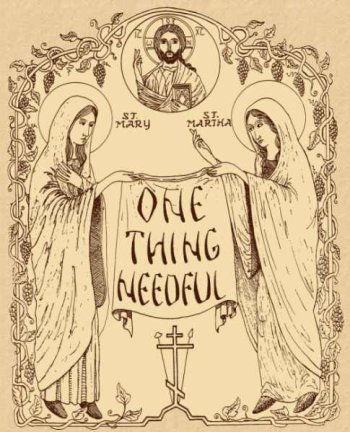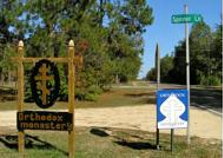








Orthodox Church in America
Diocese of the South
65 Spinner Lane
Wagener, SC 29164 - USA
telephone: 803-564-6894
email address:
Mary_MarthaM@pbtcomm.net


         Saints Mary & Martha
Orthodox Monastery
Orthodox Church in America Diocese of the South 65 Spinner Lane Wagener, SC 29164 - USA telephone: 803-564-6894 email address: Mary_MarthaM@pbtcomm.net |
  |
|
See old newsletters
ONE THING NEEDFUL
OCTOBER 2010 BALANCE
Another change of season – they come so quickly! We find ourselves both happy and sad with the change – the colorful leaves, the need to rake leaves; the cooler weather, too cold; shorter daylight, longer nights. It is much the same with our lives – Nothing is perfect so we seem to fluctuate between happy/sad, good/bad, satisfied/dissatisfied. The struggle is always trying to find a balance – the balance is our good God. The more we allow Him to be active in each moment of our day, the more we can handle, the happier we are because we are not alone – our triune God is always with us in every situation we find ourselves. So how do we become more aware of His Presence? We need to pray for this gift which God is most ready to give us. We need to use the gift. The more we do, the more natural it becomes to remember He is with us (We’re very awkward at first – are we talking to ourselves?, etc.) and will provide the strength we need to do whatever is called for at the moment – whether it be patience, wisdom, physical strength, compassion, silence . . . Therefore, with this change of season, let us pray and change our everyday living to one of better balance – of living each moment in Christ Jesus through the Holy Spirit to the glory of God the Father.  MONASTERY NEWS
It is rare that we open our newsletter by being preachy; however, we feel the following needs to be said. We know it takes concerted effort and single mindedness to have a beautiful church in which to worship God, Father, Son, and Holy Spirit. For fifteen years, we have worshiped in our temporary chapel which is technically the formal dining room area of our doublewide. While we long for and work toward the day when we will have a “real” chapel with an altar, an iconostasis, along with all the “trimmings”, and that includes more nuns, we continue to strive to make it as beautiful as we can. So often we hear from parishioners in various parishes/missions that they cannot spend money or take the time to make God’s sanctuary beautiful and keep it in good order. Why is it so difficult for them to spend time, talents and money to do this? Visitors to our churches or monasteries take note of how we take care of God’s sanctuary. Is it clean? Are things in order? Does it draw them nearer to God by its beauty and sense of peace and holiness? How does the church/chapel in which we worship witness to our love of Christ? Why are we so miserly, when God lavishes so much on us? 
Recently, Konstantin, a metal fabricator, designed, made and installed a beautiful new sign at the corner of Highway 113 and Spinner Lane. Many of our visitors have commented on its attractiveness. The smaller sign was given to us several years ago and continues to help people find our monastery, especially in the dark. When visiting friends in Texas, to Mother Thecla’s great surprise, Alexander handed her a late nineteenth century Russian Icon of the Church’s major Feast Days for our monastery. It has been framed in a shadow box and now hangs on our walls. Above this icon hangs a wonderful print of Our Lady of Guadalupe which is from her shrine in Mexico. When visiting Mexico, Marta was given it by some of our friends in Mexico to give to us. As if that was not enough, on her trip to the Baltic countries, Cynthia brought us an icon of the Theotokos with Christ that had been carved from amber. The comings and goings of many plants also continues to be a source of joy. From Tikhon we received several thornless blackberries, from Donna crinum and loropetalum, and from Linda night and day blooming cereus. Many are the people who support us in numerous ways. For this and so much more, we are grateful. Another gift was our being at the baptism of two of Eugene and Despina’s grandchildren, one on July 11th and the other on July 18th. Once again the Diocese of the South, Diocesan Assembly was held in Atlanta, Georgia from July 20-23. Mother Thecla attended as the representative from this monastery. She delivered a brief, oral report in addition to the monastery’s written report. As always, it was joyful to greet old friends, meet new ones, and pray and work together toward the building up of God’s Church in this Dioceses and beyond. 
On July 30th, we lost Vivaldi, our Manx cat. He was a gentle cat who enjoyed sitting in the middle of any puzzle we were working on and took all too much pleasure in passively annoying Arnora, our skitty kitty. All of us miss him deeply. On Sunday afternoon, August 1st, we attended a performance of King David, a symphonic psalm from 1923, with music composed by Arthur Honegger and a narrative written by René Moraz. Michael Lu, a talented singer from Holy Apostles Orthodox Church in West Columbia, South Carolina, sang in the chorus. As usual, August and September in South Carolina were hot and humid which, in turn, limited our working outside. Services continued to be prayed, visitors were welcomed, candles were made and shipped, much thanks was given for air conditioning, and, in general, the work of maintaining this monastery remained on going.
Two weeks later, we hosted a retreat for twelve women from St. Anne Orthodox Church in Oakridge, Tennessee, from October 8th through the 10th. Meeting these women who are serious about Orthodoxy and strive mightily to live their Christian faith was truly a great joy for us. God is wonderful in His Saints. We must join this cloud of witnesses.  ROBE OF THE THEOTOKOS
(July 2nd) (continued) Throughout 1200 years of the Byzantine Empire, the Theotokos saved Constantinople from famines, pestilences, earthquakes, foreign armies and navies, and a multitude of other calamities. The most notable manifestations of her protecting this great city from attackers are recorded in various accounts of military assaults from the Avars and Persians in 626, the Persians in 677, the Arabs in 717, the Russians in 860, the Arabs in 864, the Slavs in 911, and the Bulgarians in 926.
The Secret History of Procopius
http://penelope.uchicago.edu/Thayer/E/Roman/Texts/Procopius/Anecdota/maps*/Constantinople.html
The Robe of the Theotokos was specifically used by the Byzantines against the attack of the pagan, Russian army and navy which began on June 18, 860. This invasion and the events thereafter are recorded by the Byzantine chronicler Saint Nestor and the Russian chroniclers Ioakimov and Nikonov. With two hundred ships and five thousand soldiers, Prince Askold of Kiev sailed down the Dnieper River and across the Black Sea to invade Constantinople from the Bosporus Sea, the Golden Horn, and the Sea of Marmora. Constantinople and the surrounding area were defenseless. Their soldiers and sailors were divided between fighting a war against the Arabs in the east and a war against the Normans in the Aegean and Mediterranean Seas in the west. Even their Emperor Michael III (840-867) had just set out with troops in his campaign against the Arabs when he received word of the invasion and was forced to turn back. The Russians were laying waste the coastal regions around Constantinople, killing many as they went. Patriarch Photios summoned the people to an all-night vigil to repent and to implore the Theotokos to deliver them from this enemy. Upon reaching the Church of the Theotokos of Blachernae, Emperor Michael III prostrated himself on the floor and prayed throughout the night. After the all-night vigil, it was decided to take the precious robe from the amber chest in the Hagia Soros (the round reliquary building beside the church). With fear and trembling, they opened this chest. The fragrance of myrrh filled the church and the environs thereabout. The imperial purple silk had disintegrated, but the robe was incorrupt. Bearing aloft this most sacred and pure robe of the Theotokos, a great and solemn procession was made from the Church of the Theotokos of Blachernae to Hagia Sophia by way of the sea wall. At one point, the edge of the Virgin’s robe was dipped into the Bosporus Sea. All the while, the people were begging God to have mercy upon them and asking the Theotokos for her protection. The Theotokos safeguarded the city, and shortly afterwards the Russian warriors ceased their pillaging and killing. Prince Askold lifted his siege of Constantinople when he and Emperor Michael III came to an honorable truce. The main conditions of the treaty included the payment of an annual tribute by the Byzantines to the Russians, authorization for Russians to serve in the Byzantine army, allowing Russians to trade in the Byzantine Empire, the Baptizing into Orthodox Christianity Prince Askold and Kievan Rus, and the establishment of diplomatic missions in Constantinople and Kiev. With the payment of a large tribute, the Russians began departing on June 25th. To return the wonder-working robe of the Theotokos to her church in Blachernae, an all-night vigil was held. In attendance were the emperor, the senate, the clergy, and most of the people of Constantinople. After they venerated the robe of the Theotokos and kissed the amber chest in which it was contained, Emperor Michael III and Patriarch Photios removed their crown and miter and, with great solemnity, processed the three miles carrying the amber chest with her robe to the Church of the Theotokos of Blachernae. In remembrance of these events, both Emperor Michael III and Patriarch Photios established July 2nd as the feast day of the Deposition of the Robe of the Theotokos. They also instituted a Friday evening vigil that included a procession from the church in Blachernae to the Church of the Theotokos in Chalkoprateia (in the old part of Constantinople) which contained most of the Girdle (belt) of the Theotokos. It is believed that Patriarch Photios composed the beautiful “Akathist to the Holy Mother Theotokos” (an ancient form of Christian poetic prayer) which is prayed on the Fifth Saturday of Orthodox Lent to this day. Even though there was much pressure from the Jews and the Moslems to convert to their faith, it is interesting to note that Prince Askold opened up Kievan Rus to Orthodox Christianity through his acceptance of baptism and the baptism of some of his people.
Byzantine historian, Nikephoros (1295-1360), recorded having seen the incorrupt robe, cincture, and veil at the Church of the Theotokos of Blachernae. In the journal of a Russian traveler, Stephen of Novgorod (1350) writes that he and those with him saw the sealed coffer which contained her robe, cincture and veil on the altar of this same church. As the Theotokos saved Constantinople, so also she saved Moscow on the Feast Day of the Deposition of Her Robe. In the summer of 1451, Prince Mazovshi with his Tartar army laid siege to Moscow. Metropolitan Jonah of Moscow led the Orthodox Christian faithful in continuous prayer services and did much to encourage those defending the city. A Russian chronicler recorded that, on the night of July 2nd, there was much confusion among the Tartar Horde which caused them to abandon their camp suddenly and in great disarray, thus leaving what they had plundered. With much gratitude, Metropolitan Jonah built the Church of the Deposition of the Robe of the Theotokos in Moscow in memory of this great miracle. During a trip to Constantinople, Archbishop Dionysius of Suzdal, Russia acquired a piece of her robe and placed it in the Church of the Annunciation in Suzdal, sometime between 1382 and 1384. Several conflicting accounts exist of how or when the robe of the Theotokos came to the Dormition Monastery in Khobi, Georgia. It is known that her robe was preserved in a silver case which bore two seals, that of the Catholicos and of Prince Levan II Dadiani (reigned 1611-1657), and placed on the monastery altar. Redot Elchin and Pavel Zakharev, Russian envoys, attested to seeing the robe when they visited the Dormition Monastery in 1640. Other 17th century visitors to Khobi were Giuseppe Maria Zampi (an Italian missionary), one of the Patriarchs of Alexandria, Egypt, and several monks from Mount Athos. During the early Soviet era, 1923-1936, the Theotokos’ robe was transferred to Dadiani Palace Museum in Zugdidi, Georgia, where it remains today. Each year on July 2nd, the faithful of Zugdidi along with many pilgrims carry her robe in procession from the museum to the Cathedral of the Blachernae Icon of the Theotokos. The importance of the Church of the Theotokos of Blachernae, the relics of the Theotokos which it held, and the many miracles that the Theotokos performed therein have, over the centuries, inspired many to build churches in honor of the Deposition of the Robe of the Theotokos. Besides the two churches mentioned above, another well know church built in honor of this feast day was erected by Holy Prince Andrew Bogoliubsky at the Golden Gates of Kiev. On January 19, 1434, the Church of the Theotokos of Blachernae burned down. There seems to be no record of what happened to the chest containing her robe and other garments. With Constantinople weakening from the many military campaigns waged against it by the Ottoman Turks and finally falling on May 29, 1453, to Moslem rule, this great church has never been rebuilt. Only the sacred spring (Hagiasma) continued flowing and remained in Ottoman hands until the Guild of Greek Orthodox Furriers purchased it in 1867 and constructed a small church around it which stands to this day. The Lives of Georgian Saints, by Archpriest Zakaria Machitadze, trans. David & Lauren Elizabeth Ninoshvili, St. Herman of Alaska Brotherhood, Platina, California, 2006 The Great Synaxaristes of the Orthodox Church, July, Holy Apostles Convent, Buena Vista, Colorado, 2008 
|
  
December 11th at 9am
January 8th at 9am February 5th at 9am March 5th at 9am Matins starts at 8am Young Adult Retreat
There will no longer be a Young Adult Retreat at
Saints Mary and Martha Orthodox Monastery. This retreat is transitioning to the Nativity OCF Retreat at the Diakonia Center, Salem, SC. http://www.oca.org/news/2298 or http://www.ocf.net/wikis/programs/college-conference-2010.aspx Knitters' Retreat
February 18-20, 2011
Contact Maria Floyd: 803-642-4402 OR Email her at mariajfloyd@gmail.com This retreat is for women 21 years of age and older. Due to limited space, we can only accommodate twelve women. If you plan to attend, come for the entire retreat. You need to have a project or projects that you can work on without help from other knitters. God willing, we will have a priest to serve Liturgy on Sunday morning.  FROM MARTHA'S KITCHEN Moroccan Vegetable stew
1/3 cup corn oil Prepare all ingredients, placing them in separate containers, lining them up in the order listed. This takes time, so get a helper. In a large soup pot, heat oil on medium and sauté onions till soft. Add carrots and peppers and sauté for three minutes. Add garlic, ginger, cumin, turmeric, coriander and sauté for two more minutes. Add vegetable stock and hot water, cinnamon sticks, bay leaves, black pepper and lentils. Bring to boil, lower heat, and simmer, uncovered, for 20 minutes. Gently stir in zucchini, green beans, eggplant, tomatoes, raisins, and salt. Simmer for another 15 minutes. Remove cinnamon sticks and bay leaves. Add cilantro, mint, spinach, and lime juice. Stir well until the spinach is wilted. Remove from heat and let stand for 15 minutes. The flavor is better if it can stand for an hour or two. In large heat-proof, flat-bottomed container which has a tight lid, pour 4 cups of couscous and pour 6½ cups boiling water. Stir well and cover with lid for 20 minutes. Remove lid and fluff. NOTE: Quinoa or rice can be used, if you prefer. Serves: A Goodly Number |